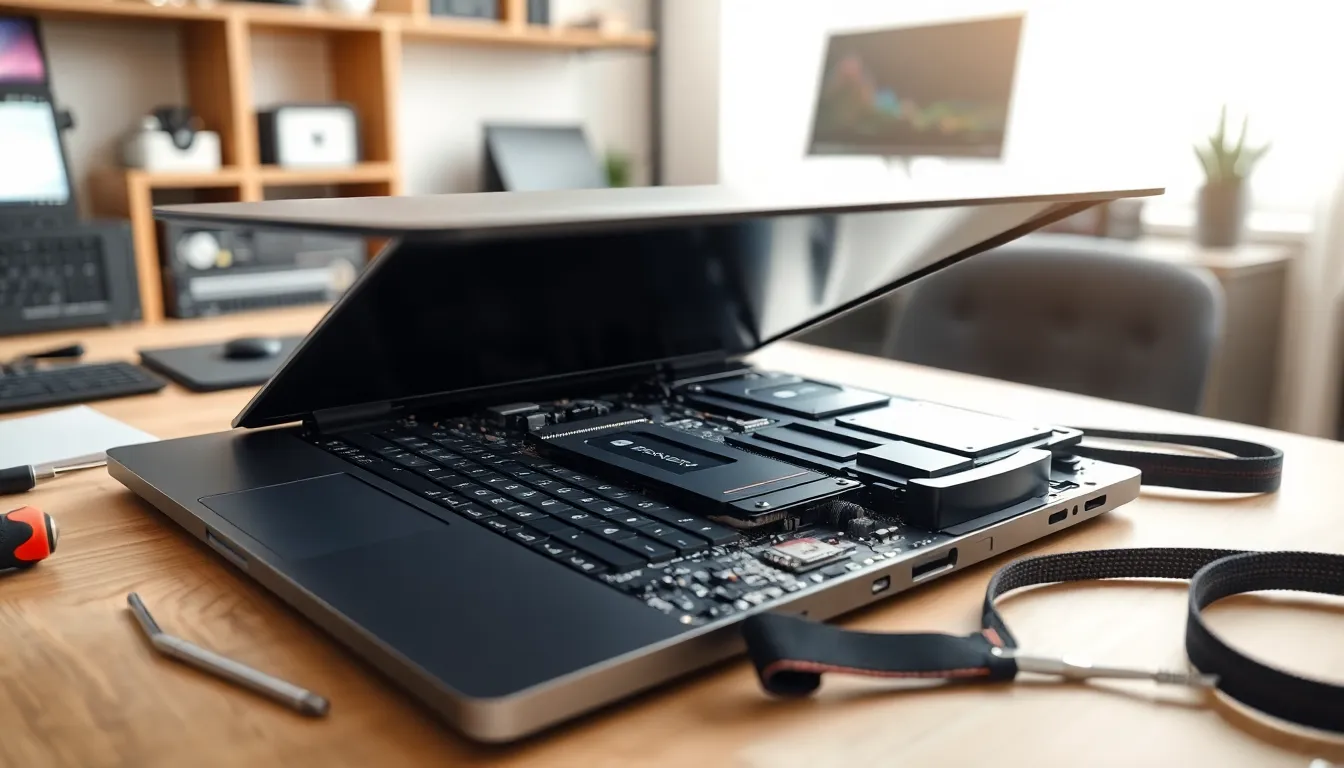Table of Contents
ToggleIn today’s fast-paced digital world, keeping a laptop running smoothly is essential. As software demands grow, users often find their trusty devices lagging behind. Fortunately, laptop hardware upgrades can breathe new life into aging machines, enhancing performance without the need for a complete replacement.
From boosting RAM to upgrading storage solutions, these modifications can significantly improve speed and efficiency. Whether it’s for gaming, graphic design, or everyday tasks, understanding the options available empowers users to make informed decisions. With the right upgrades, a laptop can transform into a powerhouse, ready to tackle any challenge.
Understanding Laptop Hardware Upgrades
Understanding laptop hardware upgrades enhances performance and extends device longevity. Users can tailor their machines to meet specific demands, whether for gaming, productivity, or creative work.
Importance of Upgrades
Upgrades play a crucial role in maintaining laptop efficiency. They address the limitations of older models, allowing for improved processing speeds and multitasking capabilities. Upgrading components like RAM and storage leads to faster boot times, quicker file access, and a smoother user experience. Regular enhancements can significantly increase the lifespan of a laptop, postponing the need for a complete replacement.
Common Upgrade Components
- RAM (Random Access Memory)
Increasing RAM improves multitasking performance and allows for running more applications simultaneously. Typical upgrades range from 4GB to 32GB, depending on the laptop’s specifications.
- Storage Drives
Upgrading from a traditional hard disk drive (HDD) to a solid-state drive (SSD) results in faster data retrieval and improved system responsiveness. Users often opt for capacity upgrades of 256GB, 512GB, or 1TB SSDs.
- Graphics Cards
While many laptops come with integrated graphics, upgrading to a dedicated graphics card enhances gaming and graphic design capabilities. Some models support external graphics processing units (eGPUs) for added flexibility.
- Battery
Replacing older batteries provides better battery life and device portability. Users can choose from high-capacity options to meet their mobility needs.
- Cooling Systems
Upgrading cooling systems ensures optimal temperatures during heavy usage. Enhanced cooling solutions prevent overheating, prolonging component life and reliability.
- Wi-Fi Cards
New Wi-Fi cards can support faster connectivity standards, improving internet speeds. Upgrading to Wi-Fi 6 capable cards enhances overall network performance.
Types of Laptop Hardware Upgrades

Identifying the types of laptop hardware upgrades offers insight into maximizing performance and extending device longevity. Key areas for upgrades include RAM, storage, and graphics cards.
RAM Upgrades
Upgrading RAM enhances multitasking capabilities and speeds up application responsiveness. Users can typically increase their RAM by replacing existing modules or adding new ones. Most laptops support a range of RAM sizes, often between 8GB and 32GB, depending on the model. For instance, upgrading from 4GB to 16GB can significantly improve performance in resource-intensive tasks like video editing or gaming. Always check the laptop’s specifications before purchasing compatible RAM modules.
Storage Upgrades
Storage upgrades can lead to notable improvements in data access speeds. Transitioning from a traditional hard disk drive (HDD) to a solid-state drive (SSD) results in faster boot times and application loading. SSDs are available in various capacities, typically ranging from 128GB to 2TB. Users may also consider adding a second drive for additional storage space, enhancing overall system performance. When upgrading, ensure compatibility with the laptop’s form factor and interface type, such as SATA or NVMe.
Graphics Card Upgrades
Upgrading the graphics card can dramatically improve visual performance in gaming, graphic design, and video rendering tasks. Although many laptops come with integrated graphics, some allow for dedicated graphics card upgrades. Users looking for enhanced performance should evaluate options for external GPU enclosures if the laptop lacks an upgradeable internal card. The upgrade process may vary based on the laptop’s make and model, so thorough research is crucial to ensure compatibility and performance gains.
How to Choose the Right Upgrades
Choosing the right hardware upgrades requires careful consideration of compatibility and performance impact. Users can enhance their laptops effectively by focusing on specific components that align with their computing needs.
Compatibility Considerations
Compatibility plays a crucial role in selecting upgrades. Users must verify that components, such as RAM, storage drives, and graphics cards, match their laptop’s specifications.
- RAM: Confirm the maximum supported RAM size and type (e.g., DDR4) to prevent mismatches.
- Storage: Check the physical size (2.5-inch, M.2) and interface (SATA, NVMe) for storage drives. Not all laptops support SSDs, so ensure compatibility with the existing hardware.
- Graphics Card: Verify if the laptop allows GPU upgrades. Many laptops have integrated graphics, limiting upgrade options to external GPU enclosures.
- Cooling Systems: Assess compatibility with the laptop’s design to avoid overheating issues after upgrades.
Consult the laptop manufacturer’s website or user manual for detailed specifications and upgrade options.
Performance Impact
Performance impact varies based on the chosen upgrade. Each component significantly enhances overall functionality:
- RAM: Upgrading from 8GB to 16GB or higher can double application performance, enabling smoother multitasking and faster load times for demanding applications.
- Storage: Transitioning from an HDD to an SSD typically reduces boot time to about 10 seconds and improves application launch speed by up to 80%.
- Graphics Card: A dedicated graphics card can enhance gaming frame rates by 50% or more, allowing for higher resolutions and settings in demanding games.
Evaluating the specific performance enhancements from each upgrade ensures users select components that yield the greatest benefits for their usage scenarios.
Installing Hardware Upgrades
Installing hardware upgrades can significantly enhance laptop performance when done correctly. Following a structured process ensures optimal results and compatibility.
Step-by-Step Guide
- Gather Tools and Materials
Ensure you have the necessary tools, including a screwdriver, anti-static wrist strap, and the new hardware components.
- Back Up Data
Back up important files to prevent data loss during the installation process.
- Power Down and Disconnect
Power down the laptop and disconnect it from any power source. Remove the battery if the model allows.
- Open the Laptop
Carefully remove the screws and gently open the laptop casing to access the internal components.
- Install RAM
Align the RAM module with the slot and insert it at a 30-degree angle. Press down until it clicks into place.
- Replace Storage Drive
Remove the existing hard drive by unscrewing it from the bracket. Insert the new SSD or HDD into the slot and secure it.
- Install Graphics Card (if applicable)
For laptops with upgradeable GPUs, remove the old graphics card and slide the new one into the PCIe slot until it clicks.
- Reassemble the Laptop
Carefully close the laptop casing, ensuring no wires are pinched. Reinsert and tighten all screws.
- Power On and Test
Reconnect the power, insert the battery, and power on the laptop. Verify the system recognizes the new components.
Tips for Successful Installation
- Consult the Manual
Reference the laptop’s user manual for specific instructions on accessing internal components.
- Check Compatibility
Verify that each new hardware component is compatible with the laptop’s specifications to avoid installation issues.
- Work in an Anti-Static Environment
Utilize an anti-static wrist strap and work on a non-static surface to minimize the risk of damaging components.
- Handle Components Carefully
Avoid touching the metal pins on RAM or graphics cards to prevent static damage.
- Keep Track of Screws
Organize screws and small parts during disassembly to ensure proper reassembly.
Following these steps and tips can lead to a successful hardware upgrade, enhancing the laptop’s performance while minimizing risks.
Upgrading laptop hardware is a powerful way to breathe new life into an aging device. By focusing on key components like RAM, storage, and graphics cards, users can significantly enhance performance and extend the laptop’s lifespan. These upgrades not only improve speed and efficiency but also ensure that the device can handle demanding tasks with ease.
Taking the time to research compatibility and installation processes can lead to successful upgrades. With the right enhancements, laptops can meet the evolving needs of users, making them more capable and efficient for years to come. Embracing hardware upgrades is a smart investment in both performance and longevity.







